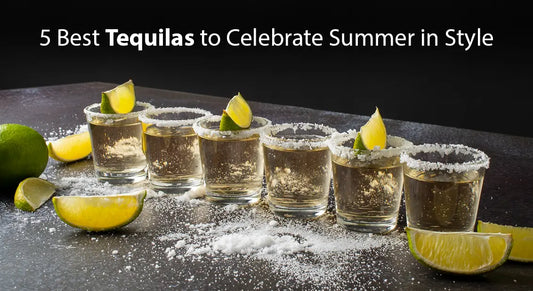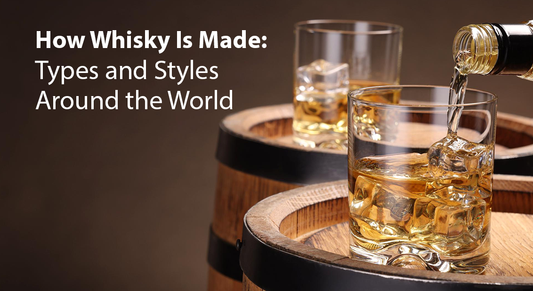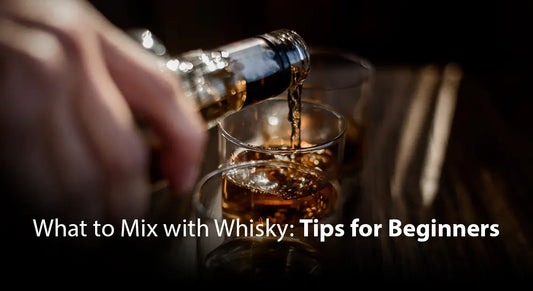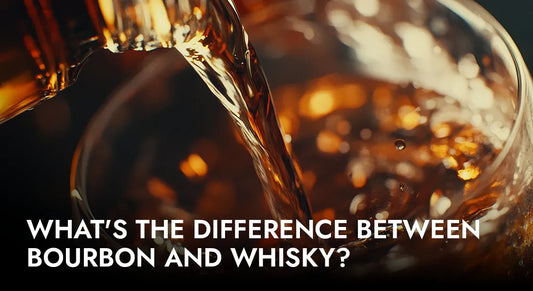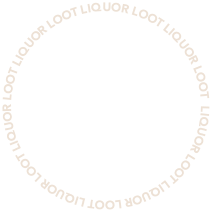
A Guide to the Different Types of Whiskey
Whiskey is a broad category of drink, and that’s great because it means the whiskey drinker can go their whole life without ever getting bored of their favourite hobby. But all the possibilities can be a bit overwhelming, too. There are a lot of whiskey types coming from different industries, and there’s a lot of vocabulary to navigate. How exactly do you tell your scotch from your bourbon?
Whiskeys can vary wildly in quality and taste, and if you jump into them blind, you may not get anything near what you were hoping for. So to ease the process of hunting down that perfect after dinner drink, we’ve compiled a crash course on the main whiskey types, what sets them apart from one another, and what you can expect from each one.
A Whiskey Debrief
Whiskey is grain alcohol that’s popular the world over. It manages to simultaneously be synonymous with the classy and the relaxed. Whiskey can be very affordable or it can be ludicrously expensive. It’s a wide class of drink with unlimited possibilities.
Whiskey is made from a variety of different grains, including rye, corn, barley, wheat, and sorghum. When these grains are fermented, they break down into sugars, the beginning of whiskey.
Whiskeys are much less standardized than other types of alcoholic drinks. No two are alike, even from the same distillery, and there is a finite amount of each whiskey “run.” Once a distillery has bottled all the whiskey from a certain run, that exact drink will never be truly replicated again.
Whiskeys are some of the most diverse drinks in terms of taste. Many people may try their first whiskey, dislike it, and mistakenly think they are simply not a whiskey person. But with the sheer multitude of flavours out there, there is bound to be something for most people. Finding the whiskeys that cater to your particular palette is a lot of work, but it’s some of the most fun work you’ll ever sign up for.
Whiskeys taste different depending on a lot of factors ranging from the ingredients to the length of time spent ageing, and even the type of barrel used in the distillation process. This multitude of factors is part of what makes each batch of whiskey so unlike any other.
If you're new to malt or grain expressions, our blended whisky collection is a great entry point
What defines a whiskey “type”
There are five basic whiskey types: Single malt, blended malt, blended whiskey, barrel proof, or single cask. Most countries produce some or all of these whiskeys, though some are more common in certain areas than others.
Single malt whiskey
Single malt whiskey uses only one type of grain and comes from a single distillery. You may be surprised to know that whiskey often moves around a bit while it distils. If it is transferred from one distillery to another before it’s finished, then it technically can’t be called single malt whiskey (not that there aren’t a few brands that slip through on technicalities in that area).
Single malt whiskey is often hailed as the preferred whiskey type for some whiskey fans because the limitations on movement make the drink very regional. Every distillery will have a distinct taste, and keeping things single malt makes those regional flavours come out strong.
Blended malt whiskey
This whiskey is actually a combination of several single malt whiskeys made in separate distilleries. Sometimes the mixing of two delicious malts yields even more amazing results.
Blended whiskey
Here is truly the wild card of whiskeys. Almost any whiskeys can be mixed together during the creation of a blended whiskey, very little is off the table. To some people, blended whiskey is synonymous with cheap, but it’s here that you’ll get some truly unique flavour combinations impossible to achieve with a single malt.
Single barrel
Sometimes also called single cask, this whiskey is bottled from one specific distillery cask. Limiting the whiskey to a single cask helps preserve the casks unique flavour, as taste can differ even within the same distillery.
Cask Strength
Cask strength (or barrel proof ) is a whiskey that skips the dilution process and is instead bottled straight from the cask. Talk about packing a punch!
How much alcohol is in whiskey?
You may be curious about the strength of the various whiskeys as they compare to other alcoholic beverages. Well don’t worry, most governments have very strict guidelines for whiskeys, partly because alcohol is highly regulated, to begin with, and partly because the whiskey industry likes to have its rules as to what can or cannot be called true whiskey.
Whiskey contains much more alcohol than your average beer. The standard measuring for a whiskey’s alcohol content is something called ABV, which stands for alcohol by volume. While most beer won’t go above 10 percent, whiskey usually starts at 40. Some countries even have rules preventing anything below 40 percent from even being called whiskey.
Where whiskey comes from and why it matters
Whiskey is made all over the world, sometimes in unexpected places. (The Tasmanian whiskey industry, for example, could fill a whole vacation for the avid distillery tourist.) And you’ve probably heard how certain drinks can only technically exist in very specific locations, such as bourbon coming from Kentucky.
And it’s this locational distinction that also gives us the two different spellings of whiskey. For quite a while the two spellings were considered interchangeable in the English-speaking world, at least until the last half century or so. Now the unofficial rule behind “whiskey” and “whisky” is that the former describes American whiskeys, while the latter is applied to spirits from other countries. However, Ireland typically uses the “whiskey” spelling, as well, and you’ll see some specific companies that latch onto one or the other, regardless of location.
It’s a fun little trivia fact to know, but ultimately you’re safe to choose whichever spelling doesn’t upset your spellchecker.
While whiskey is made all over the world, some industries are bigger and more well-known than others. The main whiskey homelands are the United States, Ireland, Scotland, Canada and Japan.
American Whiskey
American distilleries crank out more than just bourbon. Rye is a close second when it comes to popular whiskey categories. The United States makes a lot of both, unsurprising with how big of crop corn is over there, and there are many stipulations about the barrel types used.
The U.S. is also known for a plethora of blended whiskeys and a special kind of Tennessee bourbon that is filtered through charcoal. Love rich, sweet flavours? Explore our Bourbon whiskey collection for US-made classics.
Canadian Whiskey
America’s neighbour to the north has quite the selection of whiskey distilleries, as well. Canadian whiskeys can be a bit confusing. Like American bourbon, they’re rich in corn, but there are fewer barrel restrictions, which has resulted in a distinct flavour palette. On the whole, Canadian whiskeys are lighter, with a touch less flavour than American whiskeys. And remember that Canadian rye, while it shares a name with American rye, is not actually made from rye and is a whole different drink.
Irish Whiskey
While the earliest record of whiskey production can be traced back to Scotland, the birth of the official whiskey distillery is a title owed to Ireland. Irish whiskey typically forgoes the smoky flavours you’ll see in Scotch or other whiskeys because the Irish rarely smoke their malts over peat. They’ve also got a whole extra category of whiskey in Ireland called “pot still whiskey” mixed from a combination of malted and unmalted barley. Curious about triple-distilled smoothness? Browse our curated Irish whiskey range.
Scotch Whiskey
The whiskey world sort of revolves around Scotland. Good scotch has for a long time been considered the pinnacle of whiskey. And while the world is certainly diversifying, Scotland remains at the centre of whiskey production for now.
Much like bourbon can only truly come from Kentucky, Scotch can only be made in Scotland (at least if it wants to be called Scotch). All scotch is at least 3 years old and bottled at 40 percent alcohol by volume or higher.
You can explore regional expressions from Islay to Speyside in our Scotch whisky collection
Japanese Whiskey
Japan is one of the youngest of the major whiskey regions, but the industry over there is growing rapidly. Japanese whiskey is most similar to scotch, but the Japanese are known for their interesting take on the western concept of whiskey, and some truly inventive drinks come from the island nation. Known for elegance and craftsmanship, our Japanese whisky selection features award-winning bottles.
Decoding whiskey taste jargon
Ordering whiskies can seem like navigating a minefield to the inexperienced. Decoding the various whiskey descriptors into something understandable in terms of taste can be even trickier. Do you want something rich or light? Smokey or delicate?
It’s hard to know what these terms mean without a basis for understanding them, which mostly boils down to trying different whiskies in each category until you know what you like. Since everyone’s tastes are a touch different, you’ll have to develop your own unique whiskey palette. You can rely on friends at first to pick out your whiskeys for you, but eventually, you’ll want to strike out on your own.
Sometimes whiskey flavours can sound completely at odds with one another. Vanilla or fruity? Green or nutty? Are we sure we’re still talking about whiskey? And words like rich or delicate can seem like brewing companies making up their own descriptions, but all of these terms actually mean something specific.
Yes, the whiskey flavour spectrum is quite diverse, but everything can actually be quite easily placed into four categories:
Rich/smokeyRich/delicateLight/smokeyLight/delicate
As a general rule, richer whiskeys are where you’ll find the nuttier, deeper flavours, or those rich spicy aftertastes. Lighter whiskeys usually bring out greener, fruitier flavours. Smokey and delicate flavours mark the border between larger and smaller amounts of peat used in the brewing process. So remember, each whiskey you try will have at least two main flavour components. Don’t be shy about trying different combinations.
The three types of whiskey order
So that’s a lot of pretty technical jargon. There’s a lot that goes into the process of making whiskey, but at the end of the day, it’s the taste that matters. When you sit down with a glass of your favourite whiskey, ready to relax and enjoy the evening, the last thing you’re concerned with is where the grain was sourced. So let’s break down one more list of important whiskey types: the different whiskey orders.
When you ask for a whiskey at a bar or distillery, they’re going to ask you how you want it. Basically, this just comes down to your feelings on the ice and whether or not you want the whiskey to be mixed with anything. But if you’d like to sound like a real whiskey connoisseur, use one of these three terms:
“Neat”
This refers to straight bourbon. You get the glass, you get the whiskey and nothing else to get in the way of the whiskey’s taste.
“On the rocks”
The rockier cousin of the neat order. Asking for your whiskey on the rocks just means you’re getting a handful of ice cubes in your glass. This provides a nice chill to the drink, but some people avoid ice because of the potential for watering down the drink as the ice melts, and the fact that less whiskey will fit in the glass, to begin with.
In a mixed drink
If you thought whiskey was a solo drink, think again. There are plenty of mixed drinks that use whiskey as a base, and you should absolutely give some a try. Lemon-lime soda, orange juice, and all the other usual suspects can make a great companion to your whiskey.
Not sure where to start? Our whisky tasting packs let you try before you buy.
At the end of the day, there’s no wrong way to drink whiskey, so don’t let anyone try to convince you otherwise. And the possibilities with good whiskey are endless. There are so many different flavours to discover, so have some fun with it. Try something new every so often, and you may just discover your new go-to drink.
Looking for a gift or countdown experience? Explore our whisky advent calendars
for a unique surprise each day.

